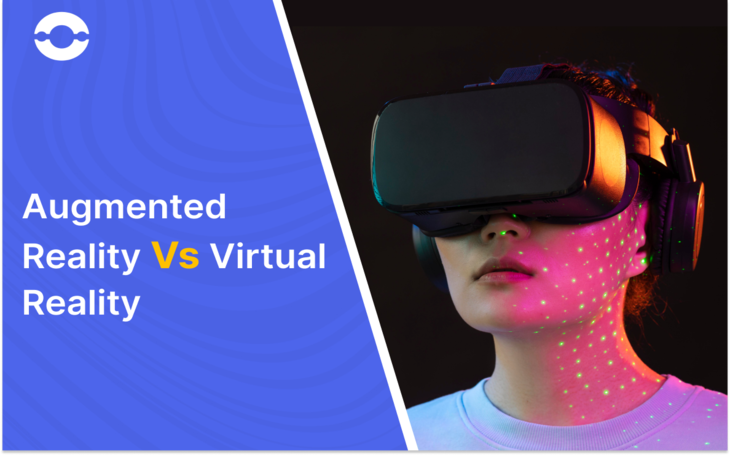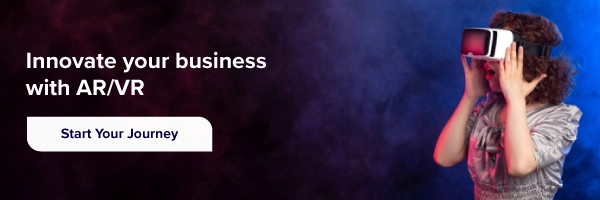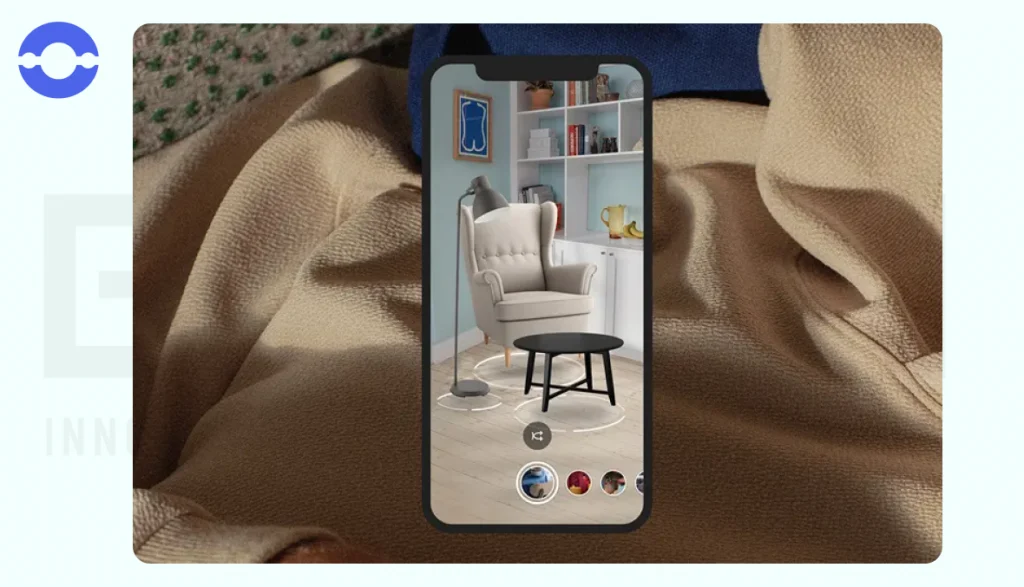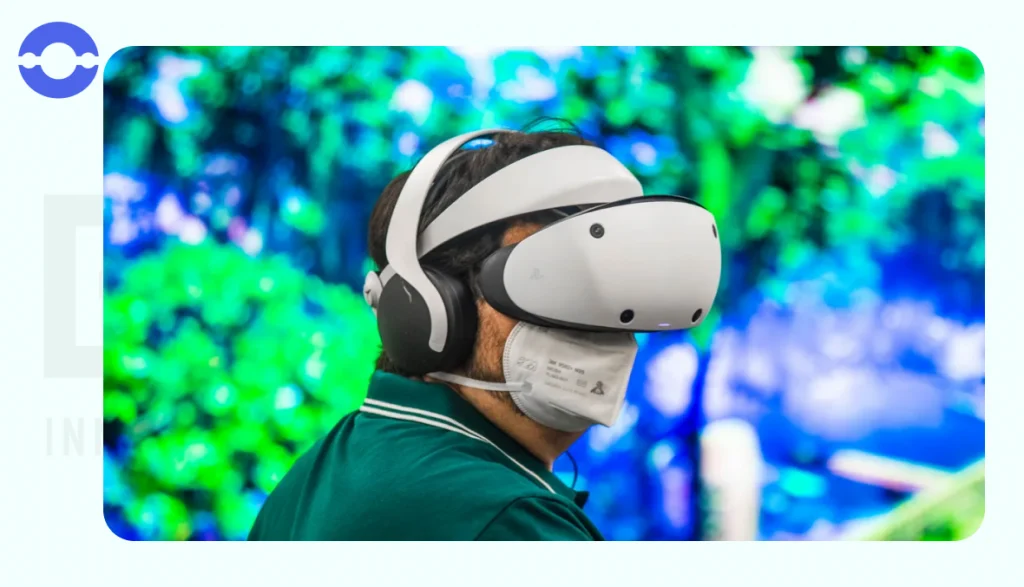
Virtual Reality and Augmented Reality have an exciting future in every field. From education to e-commerce to healthcare, so many different sectors are getting influenced by AR vs VR technologies. Moreover, These technologies are known for creating immersive experiences for users by blending the real and virtual worlds.
In this blog, we decided to share core insights with you about how AR/VR technologies are making the life of users much simpler and will cover the difference between AR vs VR in detail.
What Is AR?
Augmented Reality relates to when the digital world is combined with natural elements. In addition, Any person who has a smartphone can get access to AR. AR removes the dullness of the physical world into the colorful and visual world by projecting virtual images using a phone camera.
AR adds things to the existing world. The word augmented Reality is derived from the Latin word “Augera,” which means to add or increase, but it does not cut out the real world.
Rather, it’s an enhancement of the real world with virtual objects. Thus, AR integrates digital information on top of the user’s physical surroundings in real time.
Augmented Reality means when the natural environment is supplemented with computer-generated virtual Reality. For Instance -Magic Leap was the first company that revolutionized the concept of AR.
With AR, users can interact with the stuff in front of them, like an object in the room. Of course, users can manipulate it and create a new environment around them.

You might have used Snapchat filters, which are the byproduct of AR technology. For Instance – Snapchat presents a layer of virtual Reality over the real world. Thus, Users can interact with virtual content in the real world.
In the case of AR, users can see virtual objects in real-world environments. Besides that, Augmented Reality completely differs from virtual Reality as VR focuses on replacing the real-world environment.
Think of AR as the perfect mix of the physical world and virtual elements to create an artificial environment.
Thus, The scope of AR has expanded to various sectors, including mobile computing, healthcare, the aviation industry, and other businesses.
Examples of Augmented Reality
Here are the Instances of AR-
1. IKEA App

AR has huge applications in the retail domain. You might have heard of the IKEA app hundreds of times; allowing shoppers to visualize products before they make a purchase.
Customers can imagine how tables and furniture would look in your room. Moreover, You can choose various floor fittings or furniture colors in the room using drag-and-drop functionality.
2. Pokemon Go

It is another popular concept of AR. The game purely focuses on locating and catching a cartoon character that is visually present in the surrounding.
The Pokemon App notifies the users about the presence of Pokemon in the area and then the user receives directions to find them.
Thus, the cartoon character superimposes the real-life setting, which is an AR experience.
Know more: AR/VR in Gaming Industry
What Is VR?

Have you worn headsets? You might have worn it; if not, you might have heard it many times. Virtual Reality provides an immersive experience allowing the user to view 3-dimensional images by wearing specific hardware such as a VR headset.
VR refers to the technology used to provide people with virtual experiences. People can interact with that environment using VR goggles or mobile devices.
In the virtual environment, users are not only viewing the screen but are also immersed within the virtual environment and can interact with it.
Furthermore, Virtual Reality allows users to fully immerse themselves in the digitally simulated environment using a VR headset. Using VR, users can move to the virtual world and start feeling that they exist in the virtual environment.
Users wear virtual headsets and head-mounted displays to feel an alternative world. Consider a virtual reality wherein a user enters the environment and performs things there.
Examples of Virtual Reality
Here are the instances of Virtual Reality-
1. Gucci Town
Gucci, an Italian luxury brand for clothing and fashion goods, launched Gucci Town. Additionally, It is a virtual world where players can explore the town, get various insights to learn about the town’s history, and network with other players in the game.
Gucci Town is the place where people can purchase clothes for their avatars.
2. Tom Shoes
The business model of Tom Shoes works in such a way that for every pair of shoes the customer purchases, the company will donate it to someone who needs it. So, Tom Shoes launched a campaign, “walk in shoes,” allowing the shoppers to experience the journey in the virtual environment and benefit directly from the shoes.
AR vs VR
| Basis of comparison | Virtual Reality | Augmented Reality |
| 1. Replacing reality/ adding reality | VR focuses on blocking the user from Reality. Thus, VR attempts to replace Reality. | While AR aims to add a virtual layer on top of the real environment. |
| 2. Requirement of headset | Users need VR headsets to get the immersive experience | Users do not require any headset |
| 3. Isolation | In VR, users become isolated from the real world | On the contrary, AR allows the users to interact with the real word |
| 4. What does it do | VR creates an artificial environment; the real world is hidden, and the user is immersed in digital simulation. | While AR tends to modify the real environment. |
| 5. Bandwidth | VR requires 400 MBPS and above bandwidth | On the other hand, AR requires at least 100 MBPS bandwidth |
| 6. Example | Games on PlayStation or Oculus is an example of VR | Pokémon Go is an example of an AR |
| 7. Use cases | VR is commonly used in entertainment, where technology like Oculus shakes the world. Not only that, but it also makes it possible for tourists to experience tourist destinations without being there. | AR allows users to see the furniture using an app while looking at their phones. Not only that but AR is also involved in your daily routine, starting from Snapchat filters to the Measure app on your phone. |
Future of AR and VR
The future of AR/VR looks promising. AR/VR devices are there to provide immersive experiences to the user. These technologies are there to impact our lives starting from how we work and play.
A press release from Deloitte states the VR market is expected to surpass 50% by 2023 compared to the last year and accounts for 7 billion US dollars in global revenue.
Thus, AR vs VR technologies is becoming a part of digital transformation.
Research studies from Statista state that the global market size for AR/VR/MR will be 29.26 billion US dollars in 2022, and it will rise by USD 100 billion by 2026.
AR/VR is creating new opportunities.
- There has been seen a rise in VR apps. Now, developers are trying to integrate VR capabilities into mobile apps.
- Though online shopping offers multifold benefits to the users, one thing is missing – no immersive experience was there. Now, virtual fitting rooms are coming, which enable users to see what an item looks like before buying it.
Additionally, customers can wear VR headsets to walk around a virtual store, interact with staff, and feel the products in 3D before placing an order.
- AR/VR technologies create a new opportunity for individuals to make money with AR/VR content.
Because of the increasing demand for AR/VR devices, users continue to consume AR/VR content, which results in an increasing demand for content creators to produce more content.
- Many companies, including Walmart, Boeing, etc., are leveraging AR/VR technologies for training purposes
Also Read: AR/VR Advantages And Disadvantages
To Sum Up
We cannot say that only one technology is transforming people’s lives and impacting various sectors. Both AR and VR technologies have the potential to blend and thus create an immersive and interactive experience for the users.
In a nutshell, AR is all about superimposing digital content on the real-world environment. At the same time, Virtual Reality detaches the user from the real-world setting.
At BigOhTech, being the pioneer of AR/VR services, we build an intelligent AR/VR environment using robust tools and platforms, including Unity, AR core, Vuforia, etc., that increase businesses’ revenue by 5x.
Stop thinking more; start building your business with AR/VR technologies.
FAQs
Some popular examples of AR applications include the Pokémon Go game, Ikea, Sephora, and social media filters ranging from TikTok to Snapchat.
Some famous examples of VR applications include second life, google earth VR, Cinematic VR, and YouTube VR.
Augmented Reality = Virtual Element in Real World
Virtual Reality = Real element(you) in Virtual World
A common similarity between AR and VR is that both technologies allow users to interact with virtual objects. Moreover, Both these technologies provide immersive experiences to the user by blending the real world with the virtual world.




